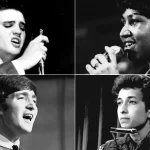
Welcome to the dazzling world of fashion where trends transcend borders and runways unite continents! In this blog post, we will delve into the captivating evolution of the modeling industry, exploring how globalization has not only shaped beauty standards but also revolutionized the way models from different regions are represented on a global scale. Join us as we uncover the influence of social media on these cross-continental catwalks and discover how Instagram, brand collaborations, and virtual runway shows have transformed the landscape of fashion forever. Let’s embark on this stylish journey together!
The Evolution of Modeling Industry Standards
Historical Perspectives on Beauty Ideals
Throughout history, beauty standards have constantly evolved, reflecting the cultural norms and societal values of their time. From the curvaceous figures of Renaissance paintings to the waif-like models of the 90s, ideals of beauty have shifted dramatically.
The Rise of Globalization in Fashion and Modeling
With the advent of globalization, fashion has transcended geographical boundaries. Models from diverse backgrounds now grace catwalks worldwide, bringing a unique blend of cultures to runways in Milan, Paris, New York, and beyond.
Impact on Globalization on Beauty Standards
Historical Perspectives on Beauty Ideals
Traveling back in time, beauty ideals have always been a reflection of societal values and cultural norms. In ancient civilizations like Egypt and Greece, symmetry and proportion were highly prized attributes. Fast forward to the Renaissance period where fuller figures symbolized wealth and fertility.
As we entered the 20th century, beauty standards started to shift with the emergence of fashion magazines and Hollywood influencing trends worldwide. The glamorous era of supermodels in the 80s celebrated diversity in body shapes but often lacked representation in terms of race and ethnicity.
In recent years, there has been a gradual move towards embracing uniqueness and inclusivity on global catwalks. With a growing emphasis on authenticity over perfection, models from all backgrounds are now gracing runways, breaking stereotypes along the way.
The Rise of Globalization in Fashion and Modeling
The rise of globalization in fashion and modeling has transformed the industry like never before. With advancements in technology and communication, models from all corners of the world can now strut their stuff on international runways.
Fashion houses are no longer limited by geographical boundaries; they can source talent globally, creating a melting pot of diverse beauty standards. This shift has opened doors for aspiring models to break into the industry regardless of their background or location.
The fusion of different cultures and aesthetics has sparked creativity and innovation in fashion design, leading to unique and eclectic runway shows that captivate audiences worldwide. Social media platforms have played a significant role in amplifying this global reach, allowing designers to showcase their collections to a vast audience instantaneously.
As we continue down this path of globalization in fashion, one thing is clear – diversity is not just a trend; it’s an essential element shaping the future of modeling.
Impact of Globalization on Beauty Standards
Diversity and representation in the modeling industry have seen a significant shift with globalization. Different regions bring unique beauty standards to the forefront, celebrating a variety of skin tones, body shapes, and cultural backgrounds. This has led to a more inclusive industry where models from various ethnicities are now being recognized for their individuality and charm.
Intersectionality plays a crucial role in shaping fashion trends globally. Models are no longer expected to fit into a narrow definition of beauty but rather embrace their diverse identities proudly on the catwalk. The fusion of different cultures and styles has brought about an exciting blend of creativity that resonates with audiences worldwide.
Challenges arise as models from different regions navigate through varying beauty norms and expectations. However, these challenges also present opportunities for growth, allowing models to break barriers and pave the way for greater diversity in the industry.
Diversity and Representation in the Modeling Industry
Diversity and representation in the modeling industry have become increasingly important in recent years. Gone are the days when a singular standard of beauty dominated the catwalks. Models from all backgrounds, ethnicities, and body types are now being celebrated for their uniqueness and individuality.
Fashion designers and brands are realizing the value of inclusivity, not just as a trend but as a necessity. The push for diversity is not only about showcasing different looks but also about giving voice to marginalized communities that have long been underrepresented in the industry.
Models with disabilities, LGBTQ+ individuals, and those from various cultural backgrounds are finally getting their chance to shine on runways around the world. This shift towards embracing diversity is not only enriching fashion shows aesthetically but also creating a more inclusive environment where everyone can see themselves represented.
As consumers demand authenticity and relatability from brands, diverse models bring real stories and experiences to fashion campaigns. By breaking traditional beauty norms, they inspire others to embrace their own uniqueness proudly.
Intersectionality in Fashion
In the dynamic world of fashion, embracing intersectionality has become crucial. It’s all about recognizing and celebrating the diverse identities that exist within society. Fashion is no longer limited to a single standard of beauty or style.
Intersectionality in fashion means acknowledging that individuals have unique experiences shaped by various factors like race, gender, sexuality, and more. This inclusivity allows for authentic representation on the runways and in campaigns.
From designers to models to consumers, everyone plays a role in promoting diversity within the industry. By highlighting different perspectives and backgrounds, fashion can truly resonate with people from all walks of life.
The push for intersectionality challenges traditional norms and fosters a more inclusive environment where creativity flourishes without boundaries. It’s about breaking barriers and redefining what it means to be fashionable in today’s global landscape.
Challenges and Opportunities for Models from Different Regions
Navigating the modeling industry as a model from different regions comes with its own set of challenges and opportunities. Models from diverse backgrounds often face hurdles such as cultural barriers, language barriers, and varying beauty standards.
Adapting to international fashion norms while staying true to one’s unique identity can be a balancing act for models hailing from various parts of the world. However, this diversity also presents an opportunity for these models to bring fresh perspectives and authenticity to campaigns and runway shows.
Opportunities arise when brands seek inclusivity and embrace cultural diversity in their marketing strategies. Models who can authentically represent their heritage have a competitive edge in an industry that is increasingly focused on representation and inclusivity.
Embracing one’s roots while adapting to global trends can open doors for models to work on cross-continental projects, fostering collaborations that celebrate diversity in the fashion world.
The Influence of Social Media on Global Modeling Trends
Social media has revolutionized the modeling industry, shaping global trends and redefining beauty standards. Platforms like Instagram have become virtual runways where aspiring models can showcase their unique styles and personalities to a worldwide audience.
Influencers now hold significant influence in fashion, collaborating with brands to create innovative campaigns that resonate with diverse audiences. This shift towards authenticity and inclusivity has opened doors for models from different regions to break into the international scene.
With just a click, users can access an array of fashion inspirations from around the globe, blurring geographical boundaries and celebrating cultural diversity on a digital stage. Social media has empowered individuals to express themselves freely and connect with others who share their passions for style and creativity.
As technology continues to advance, we can expect social media to play an even larger role in shaping global modeling trends, creating opportunities for fresh faces to shine brightly in the ever-evolving world of fashion.
Instagram and the Democratization of Fashion
In the age of social media dominance, Instagram has become a powerful platform shaping the modeling industry. With just a tap, users can access a global runway of diverse styles and perspectives.
Gone are the days when high fashion was exclusive to elite catwalks – now, anyone with internet connection can showcase their unique flair to an international audience. The democratization of fashion on Instagram has opened doors for aspiring models from all corners of the world.
Fashion influencers have emerged as trendsetters, challenging traditional beauty norms and promoting inclusivity. Brands are increasingly turning to these digital tastemakers for collaborations and campaigns, recognizing their influence in driving consumer trends.
Through hashtags like #OOTD and #StreetStyle, Instagram has revolutionized how we consume fashion content – making it more accessible than ever before. This shift towards digital platforms continues to redefine the modeling industry landscape globally.
Brand Collaborations and Influencer Marketing
Brand collaborations and influencer marketing have revolutionized the modeling industry in the era of globalization. Collaborations between fashion brands and influencers from different continents bring diverse styles to the forefront. Models now have opportunities to work with international labels, reaching global audiences through social media platforms.
Influencers act as powerful catalysts for brands seeking cross-continental exposure. Their reach extends beyond borders, introducing new trends and fashion aesthetics across cultures. This dynamic partnership creates a fusion of styles that resonate with a wider audience worldwide.
Through brand collaborations, models can break into markets they may not have accessed before. Working with influencers opens doors to new opportunities for models from various regions to showcase their talent on an international stage. The synergy between influencers and models drives innovation in the fashion landscape, pushing boundaries and redefining beauty standards globally.

